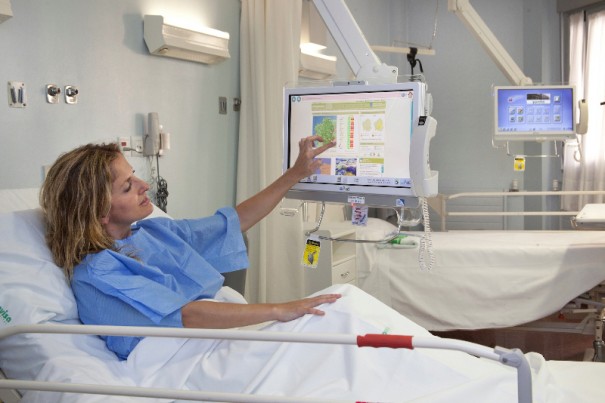They develop a touch screen to carry the electronic medical record at the foot of the hospital bed
The SoftLab Research Group of the Carlos III University of Madrid, and IonIDE Telematics, a technology-based company created as a start-up of the company Quantion and company of the Nursery of the UC3M Science Park, collaborate together on an innovative touchscreen project that allows hospital patients with some type of disability (visual for example) Access to digital entertainment and communications services, as well as consulting the patient's medical history.
Researchers at the Carlos III University of Madrid (UC3M) collaborate with the company IonIDE in the development of a system that allows hospital patients with some type of disability to access digital leisure and communications services through an intelligent terminal attached to the beds, which also allows to consult the patient's medical history. The potential of Information and Communication Technologies (TIC) In the area of health it is important, According to researchers. "ICTs will contribute to a change of focus in care and health services", comments Jesús Espinosa, CEO of IonIDE Telematics.
According to accreditation and standardization associations, Spain is at the forefront in the management of clinical processes, as it has the highest number of hospitals that have adopted the electronic health record (EHR). This computerized record of social data, Preventive and medical of a patient allows to centralize all this information in an integrated multimedia system and access it when needed, in case of emergencies, Primary care or hospital admissions, For example.
In this case, IonIDE tries to place the EHR at the patient's bedside. To do this, They propose to change the traditional television that can be found in many hospital rooms, by a touch screen that can be operated with the voice through which to access all the patient's clinical information, without forgetting other ICT-related services, such as leisure and communications. In fact, have already collaborated with the Povisa Hospital Group to deploy this system through an integrated multifunctional terminal (data, voice and TV), called IonPAD, that is placed at one end of an adapted articulated arm. Now researchers at the UC3M Center for Innovation on Disability and Dependency have provided the device with a user interface for people with some degree of disability..
Luis Puente, of the SoftLab research group of UC3M and the Spanish Center for Subtitling and Audio Description (Cesya), operating in the University's Science Park, Explained: "We have developed a speech recognition system that allows the IonPAD to be operated through voice and a speech synthesis system that makes it easier for people with visual disabilities to understand what is on the screen.. Surprisingly – aim – There was no solution that would allow a person with a disability to access this type of service.". currently, The system in the testing phase has a success rate of 81 percent, although with a subsequent filtering and specific training, Researchers hope to reach final rates close to 95 percent. "The most complicated – says Luis Puente – has been to achieve an accessible interface for most disabilities and at the same time the equipment is affordable, because we have had to rely on adapted commercial equipment and open software and our own development".
This innovative multi-touch terminal can be used by medical and nursing staff to access the electronic medical record, Enter vital signs, report treatments or view reports of tests performed, as resonances, Radiographs, Etc. On the other hand, Patients can use it to make use of hospital services (Notices to Nursing, Selection from the diet menu, receive information, Etc.), for personal leisure (television, games, Etc.) and to communicate (telephone, videoconference, email, Etc.). With the introduction of the accessible terminal, Patients with motor or sensory disabilities will be able to use it (Thanks to voice commands, Audio description and subtitles) and overcome the usual barriers they have to access information technologies.
The innovation consists in providing the audio description system with the contents of the different screens and the execution of voice commands. Roberto Peña, technical director of IonIDE, has targeted: "A blind person will be able to know what content is offered and select the one that interests them simply by talking to the team.; or someone who has plaster arms can change the TV channel by telling the ionPAD terminal, without requiring the hitherto essential help of a companion or a nurse. In this way, We don't just improve the integration of the disabled, we also improve the effectiveness of clinical resources, which will allow these people to devote more time to their purely health tasks".
[youtube]HTTP://www.youtube.com/watch?v=y5B5GLMv97s[/youtube]
You liked this article?
Subscribe to our RSS feed And you won't miss anything.





